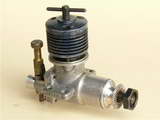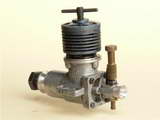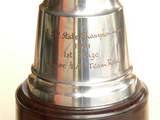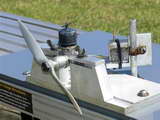A Race-Winning 1960 ED Super Fury
The subject of this report is an early Super Fury (#SF118A) which was sent in 1960 direct from ED to a well-known Australian competitor, Bert Kynoch (recently deceased). Bert recalled shortening the piston skirt. It is not clear whether any other alteration was made.
In a letter dated 1/99, Gordon Cornell asserts that the engine was a tuned version, and it does have 'MOD' stamped neatly on the edge of a lug. This would indicate that the engine may have received some special treatment before leaving the UK. In correspondence to me dated 11/08, Gordon later states that, 'The motors I sent were specially selected examples, no modifications were required - the piston could not realistically be shortened as the motor had substantial sub piston induction.'
So, Bert Kynoch may have been mistaken with regard to further piston shortening, just as there was some question with regard to Gordon's actual treatment of the engine(s). Whether more than one engine was received by Bert Kynoch is also unknown. Later examination would provide some answers.
Bert passed the Super Fury to another experienced modeler, Peter Johnson, who mounted it in a Leveret III. This was Gordon's very successful 1/2A Team racer design, later published in Model Aircraft 5/62. An early copy of the Leveret drawing accompanied the engine.
The completed model was then handed over to Bert Kynoch's nephew, John Wallace. John was a promising Junior competitor at that time and had campaigned a Taifun Hurrikan powered 1/2A with some success under Bert's tutelage. John said recently that the SF/Leveret combination placed highly in a number of local events, culminating in a prestigious 1st Place in Jnr 1/2A Team Race at the 1961 NSW State Championships.
The engine used and the trophy won in this event were kindly loaned to me by John Wallace, who also gave me permission to run the engine. This was done recently on a warm day in March. The fuel used contained 25% castor, 35% ether, 40% kerosene, plus 1.5% IPN. All props were bushed and balanced test APCs. The engine was firmly mounted in a machined alloy test-stand. As received, the backplate was indexed to give a vertical needle valve, one of the two possible positions.
The Super Fury started very easily from cold. Compression adjustment required a considerable degree of backing-off to obtain the optimum setting as the engine fully warmed. IPN content may have been too high for the warm conditions. Final needle adjustment was also quite sensitive. The engine settled down very easily, sounding very crisp and maintaining the set speed right through the 10cc tank used. The bottom end was superbly free, but the piston/cylinder fit was softer than desirable and hot restarts required several flicks. Following the last test run on the 7x3 the engine would not start easily at all and it was obvious some problem had arisen. Test results were as follows:
| APC 8x4 | 12,200 rpm | 0.183 bhp† |
| APC 7x7 | 10,200 | 0.160 |
| APC 7x6 | 12,500 | 0.199 |
| APC 7x5 | 14,800 | 0.240 |
| APC 7x4 | 15,800 | 0.254 |
| APC 7x3 | 18,300 | 0.268 |
† bhp values interpolated by Maris Dislers
from known torque absorption figures for APC props
Back in the workshop it was decided to remove only the backplate for inspection, as disturbing the cylinder in the case would be undesirable. It was immediately apparent that the plastic disc had split and would require replacement (a new disc was subsequently obtained from Gordon Cornell and fitted before returning the engine to John Wallace).
It was hoped that inspection would reveal what alterations from the original design had been made. The full diameter crank disc was unaltered. The conrod itself appeared to be original and unbushed. The limited view of the piston and cylinder did not reveal any obvious changes from original, with the possible exception of sub piston induction. This was substantial, the lower skirt clearing the exhaust port by approximately 1/16". The inlet tract from the needle valve to the disc face was as originally cast and showed no evidence of gas flowing. Nor was the plastic disc altered in any way. The venturi however was fitted with a restrictor, reducing the bore from .218" to .187". This confirmed Gordon's earlier comment that his modified engines were set-up to cover 5 miles with two pitstops only.
My conclusions are that the Super Fury was an extremely powerful engine in its day. The example tested appeared to be beautifully set-up by Gordon Cornell, though bog standard with the exception of the venturi bore and the possible enhanced sub-piston induction. There is no doubt it may well have reached 0.3 bhp with the original larger venturi and that hot starts with a decent piston/cylinder fit would have been reliably one flick.
I would like to thank John Wallace and his late uncle Bert for giving me the opportunity to examine this very interesting team race diesel.
David Owen, Wollongong, June 2009.
![]()





